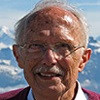7.4.5: U.S. Geological Survey
- Page ID
- 6291
Overview
The USGS receives nearly half of NEHRP funding. Funds are used to pursue four goals:
- understanding what happens at the earthquake source,
- determining the potential for future earthquakes,
- predicting the effects of earthquakes,
- developing applications for earthquake research results. Research ranges from fundamental earthquake processes to expected ground motions to building codes.
More than two-thirds of NEHRP funding is spent internally to support USGS scientists in regional programs, laboratory and field studies, national hazard assessment programs, and the operation of seismic networks, including the Pacific Northwest Seismograph Network operated with the University of Washington, the Northern California network operated with the University of California at Berkeley, and the Great Basin network operated with the University of Nevada-Reno. The remainder is spent on grants to universities, consulting firms, and state agencies, and partial support of the Southern California Earthquake Center. The external grants program is based on objectives established within the USGS with advice from outside. Grant proposals must address one or more of these objectives, which may change from year to year. The external grants program involves the best minds in the country, not just those of government scientists, to focus on earthquake hazard mitigation.
Much of the geographic focus has been on California. But starting in the mid-1980s, the USGS began a series of focused studies in urban areas at seismic risk, starting with the Salt Lake City urban corridor. After the recognition that the Pacific Northwest faced a major seismic threat, based largely on the research of USGS scientists, the Puget Sound-Portland metropolitan region was selected for a focused program that is still in progress. The results of this program were summarized in the 1990s in the two-volume USGS Professional Paper 1560, Assessing Earthquake Hazards and Reducing Risk in the Pacific Northwest. However, the San Francisco Bay Area and metropolitan Los Angeles continue to receive major research emphasis.
The Pacific Northwest program is managed from a USGS office in Seattle at the University of Washington directed by Craig Weaver; other USGS scientists working on Pacific Northwest problems are stationed in Vancouver, Washington (Cascade Volcano Observatory), Menlo Park, California, Denver, Colorado, and Reston, Virginia.
Although this program has worked amazingly well over the past two decades, it nearly ran off track in 1995–96 as a result of the Contract with America from the new Republican majority in Congress. One of the objectives of the Contract was to eliminate several government agencies, and the USGS was on the hit list. As the USGS fought for its existence and tried to save the jobs of permanent staff members, the external-grants program of NEHRP suddenly found itself eliminated by a committee in the House of Representatives. The program was later restored, thanks to assistance from Senators Mark Hatfield (R., Oregon), Slade Gorton (R., Washington), and Barbara Boxer (D., California). But before grants could be awarded, the government was temporarily shut down in early 1996, and the Department of the Interior, which includes the USGS, was forced to operate by continuing resolutions of the Congress for most of FY 1996 at significantly lower-than-normal appropriations. A year of earthquake research was lost.
A similar problem emerged in the fall of 2013 when disagreements between Congress and President Obama caused the government to shut down for sixteen days. Again, work came to a halt, and the long-term effects of that shutdown are still unclear.
The USGS assisted in organizing the Cascadia Region Earthquake Workgroup (CREW), an organization discussed in the following chapter. The USGS also operates the National Earthquake Information Center in Golden, Colorado, to locate damaging earthquakes around the world as rapidly as possible and to collect and distribute seismic information for earthquake research.
Congress has given the USGS the job of developing a real-time alert system, and, in addition, the USGS is developing an Advanced National Seismic System (ANSS) with new state-of-the-art instruments for better location and characterization of earthquakes, including the effect of earthquakes on buildings and structures. A related program is EarthScope, in which a band of seismometers was begun on the West Coast and subsequently expanded eastward across the country. This program has been managed by individual universities, starting with Oregon State University at its inception. Also under USGS direction is a project called Did You Feel It? in which people feeling an earthquake log onto a website and record their observations. Based on these observations, a seismic intensity map is published.. The Did You Feel It? map for the Nisqually Earthquake of 2001 is shown as Figure 3-16.


